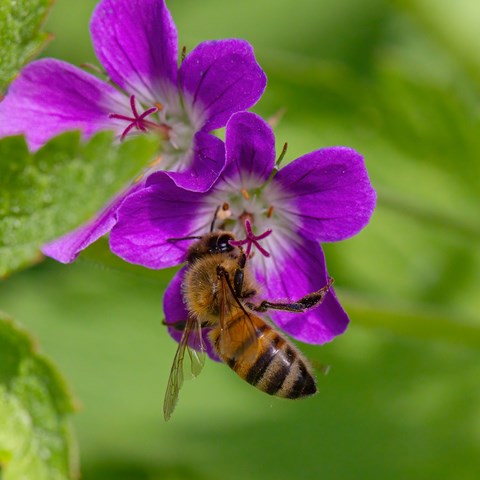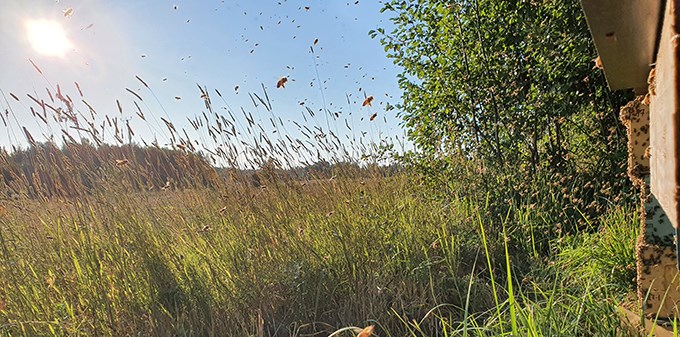A bee’s life is revealed by a spoonful of honey

Did you ever wonder about the true role of a bee to its surroundings? What flowers it feeds on, for what microbes it serves as a home and what diseases it may carry? Now a new study provides a true bee’s-eye view of the world. Researchers from Finland and Sweden show that the actions of a bee can be read from a spoonful of honey.
Describing a species role in nature is hard. Who can possibly trace where the individuals go and what they do? Now we may no longer have to attempt this. A new study suggests that the traces of an individual’s all interactions with its environment may be stored in DNA. When researchers compiled honey samples from Northern Europe, they found that a bee’s life time story may be told by the joint food stores built by the bee hive. Based on DNA left in the honey, the researchers were able to catalogue the bee’s interactions with plants, viruses, fungi and other animals.
“The cool thing here is that we can learn so much about a bee and a bee hive from its honey”, says Helena Wirta, researcher at the University of Helsinki and first author of the study. “The story of the bee – and the bee hive – is really written into a spoonful of honey. This is mindboggling, since it allows us to see all the functions honeybees do. What we cannot ask the bee about, it will tell through its honey”.
“If the DNA traces of anyone that a bee has met are actually recorded in its honey, then that is truly a quantum leap – both for me and for anyone else who is trying to understand how species come together to form ecosystems, and how together they make the world go around”, says Tomas Roslin. He is professor of insect ecology at the Swedish University of Agricultural Sciences (SLU) and co-author of the study. In his research, he studies the role of insects in ecosystems around the world.
Honeybees feed on nectar and pollen, and while doing so they pollinate the plants. Based on the amounts of DNA in the honey samples studied, the flowers most used by honeybees are crop plants such as rape seed, clovers, apple, bird cherry and strawberries. Hence, as pollinators they would mainly serve these plants.
What has been less considered before is the role of honeybees for taxa other than plants, including microbes. Viral and bacterial DNA actually formed the majority of DNA found in the honey – and what was most striking was the diversity of microbes found in honey. Among others, honey often contained the bacteria causing fire blight, a common disease of apple and pear. However, it also contained some microbes protecting plants from this disease – so the bees would actually carry both.
Furthermore, the honey hid many bacteria and fungi causing diseases in honeybees and other insects. This suggests that the bees will have a role in spreading these specific diseases – a finding offering a lead to what emerging diseases the researchers may want to keep an eye on in any particular region.
Last but not least, the researchers found that the honey would contain the DNA of a wealth of microbes living in honeybees. The honeybee itself would serve as the home to these microbes, but the bee would also depend on the microbes to stay healthy. Finding that the honeybees have been in touch with all of these taxa help us understand what the honeybees actually do in the ecosystem. In the honey itself, the microbes are typically inactivated, making honey safe to a human consumer.
“What makes honey the ideal storage for DNA are its antimicrobial properties. Its high sugar contents make DNA keep – just as a sugary jam will not be spoilt by bacteria. It is the perfect archive of nature, conveniently stored in a pot”, says Helena Wirta. “
In this study the researchers used 43 honey samples from Sweden, Finland and Estonia. Some of the samples were provided by beekeepers directly, but most of them came straight from the shop.
I am convinced that we can widen our understanding of other pollinators, too, by studying DNA in honey. Just think of the cases where we find that the honeybee and some other pollinator species visit the same type of plant. Then this plant may serve as a platform for sharing interaction partners – as involving both nice and less nice microbial partners,” says Helena Wirta
Contact
Helena Wirta, University of Helsinki
helena.wirta@helsinki.fi
+358 40 590 98 98
Tomas Roslin, Swedish University of Agricultural Sciences (SLU)
tomas.roslin@slu.se
+4618 672 383
Scientific article
Wirta, H. K., Bahram, M., Miller, K., Roslin, T., & Vesterinen, E. (2022). Reconstructing the ecosystem context of a species: Honey-borne DNA reveals the roles of the honeybee. PloS one, 17(7), e0268250. https://doi.org/10.1371/journal.pone.0268250
